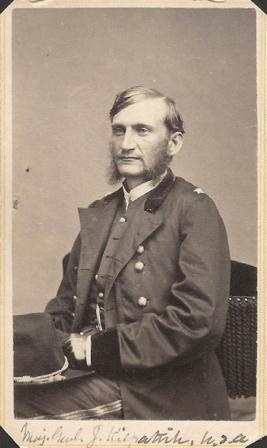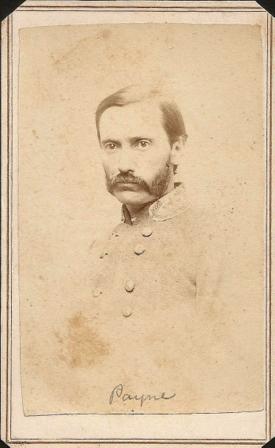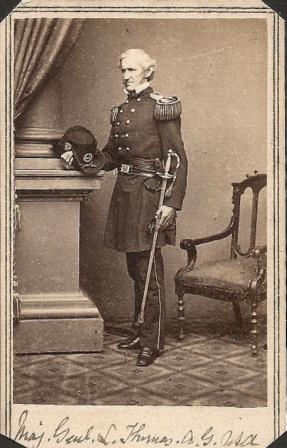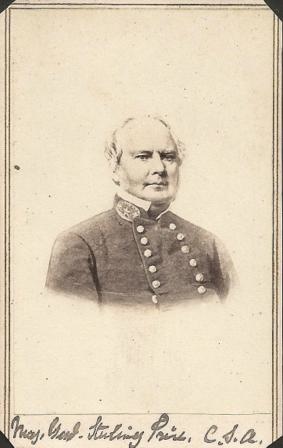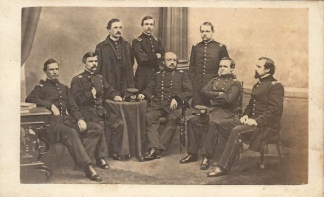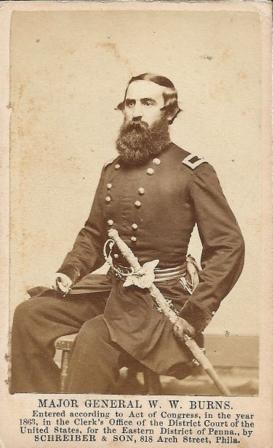|


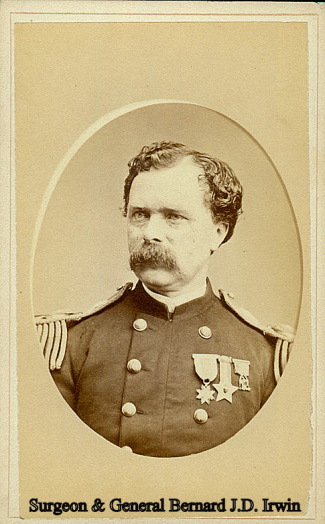
He was seriously wounded during the 1862 Shenandoah Valley Campaign
Johnson led General Stonewall Jackson's old division at Gettysburg, the Wilderness, and Spotsylvania
He was captured at Spotsylvania while defending the Bloody Angle in May 1864
Johnson was captured at the battle of Nashville, Tennessee in December 1864
From the personal collection of Surgeon & General Bernard John Dowling Irwin. Irwin has the distinct honor of being the first recipient of the Medal of Honor in U.S. military history by date of action, February 13, 1861
(1816-73) Known as "Old Allegheny," he was born in Chesterfield County, Virginia, and graduated in the West Point class of 1838, and was assigned to the 6th U.S. Infantry. He served in the Seminole Indian War, and the Mexican War. In the latter he distinguished himself for gallantry at Veracruz, Cerro Gordo, Churubusco, Molino del Rey, and Chapultepec receiving two brevet promotions, to captain and major. He also was awarded a ceremonial sword by the state of Virginia for his bravery. After the war with Mexico concluded, Johnson served on the western frontier, in the Dakota Territory, California, Kansas, and in the Utah Expedition. At the outbreak of the Civil War, he was appointed colonel of the 12th Georgia Infantry, and was promoted to brigadier general, on December 13, 1861, and major general, on February 28, 1863. He fought with distinction in the 1862 Shenandoah Valley campaign, where he was seriously wounded at the Battle of McDowell, with a bullet wound to the ankle, which took a long time to heal. He led General Stonewall Jackson's old division at Gettysburg, the Wilderness and Spotsylvania. In the fall of 1863, Johnson played a prominent role in the Mine Run Campaign. He was captured at Spotsylvania on May 12, 1864, while defending the "Bloody Angle." After his exchange from prison he led a division in the Tennessee campaign and was captured at the battle of Nashville, on December 16, 1864. He again spent months in a Union prisoner of war camp at Johnson's Island, in Lake Erie, and at the end of the war, General Johnson was moved to the Old Capitol Prison in Washington, D.C., where he was accused of being somehow complicit in the assassination of President Abraham Lincoln. Nothing came of the accusation and he was paroled on July 22, 1865. After the war he was a farmer in Virginia, and also active in Confederate veterans affairs, including early efforts to construct a monument to General Robert E. Lee in Richmond. He died in Richmond on February 2, 1873, and his body lay in state in the Virginia State Capital building until his burial at Hollywood Cemetery, in Richmond.
Wet plate, albumen, carte de visite photograph, mounted to 2 3/8 x 3 3/4 card. Bust view in Confederate uniform with rank of major general. Back mark: E. & H.T. Anthony, 501 Broadway, New York. The card mount is trimmed. Light age toning and wear. Very fine. This is the only known wartime view of General Edward Johnson in uniform. It was taken sometime after his promotion to major general on February 28, 1862. Written in period ink on the front of the card mount is, Maj. Genl. Ed Johnson, C.S.A. Written in period ink in Irwin's hand on the reverse is, Maj. Genl. Edward Johnson, C.S., Died, 1872. At 57. Genl. B.J.D. Irwin album, No. 96 is written in another hand in pencil at the bottom. Rare with this provenance literally making this image one of a kind.
History of United States Surgeon & General Bernard John Dowling Irwin
Surgeon & General Irwin was the first United States Medal of Honor Recipient by date of action, February 13, 1861.
(1830-1917) Born in County Roscommon, Ireland, he immigrated with his parents to the United States in the 1840s. He attended New York University from 1848 to 1849, and then served as a private in the New York Militia. In 1850, he entered Castleton Medical College, and he later transferred to New York Medical College, where he graduated in 1852.
He served as a surgeon and physician at the State Emigrant Hospital on Ward's Island, NYC, until his appointment as assistant surgeon in the U.S. Army in 1856. He was an assistant army surgeon during the Apache Wars, and was the first Medal of Honor recipient chronologically by date of action. His actions on February 13, 1861, at Apache Pass, Arizona, are the earliest for which the Medal of Honor was awarded! The citation on his medal of honor reads; "Voluntarily took command of troops and attacked and defeated hostile Indians he met on the way. Surgeon Irwin volunteered to go to the rescue of 2d Lt. George N. Bascom, 7th U.S. Infantry, who, with 60 men, was trapped by Chiricahua Apaches under Cochise. Irwin and 14 men, not having horses, began the 100-mile march riding mules. After fighting and capturing Indians, recovering stolen horses and cattle, he reached Bascom's column and helped break his siege."
Cochise, the Apache Indian chief, and a group of Apache warriors were accused of kidnapping a boy and a small group of U.S. soldiers in the Arizona Territory after the Army had captured Cochise's brother and nephews. When the Army refused to make a prisoner exchange, Cochise killed his prisoners. Soldiers then killed Cochise's brother and nephews. 2nd Lieutenant George Nicholas Bascom led a group of 60 men from the 7th U.S. Infantry after Cochise but was soon besieged, prompting a rescue mission by the army. In response to the siege of Bascom and his men, Irwin set out on a rescue mission with 14 men of the 1st U.S. Dragoons. He was able to catch up with the Apaches at Apache Pass in present day Arizona. He strategically placed his small unit around Cochise and his men, tricking the Apache leader into thinking that he had a much larger army with him. The Apaches fled and Bascom and his men were saved. Bascom and his men joined Irwin and together they were able to track Cochise into the mountains & rescued the young boy that Cochise had captured.
The Medal of Honor did not exist during the time of the "Bascom Incident," and would not be established until a year later in 1862. However, the actions of Irwin were well remembered, and he was awarded the Medal of Honor just prior to his retirement. Irwin's actions were the earliest for which the Medal of Honor was awarded, predating the outbreak of the American Civil War.
Irwin subsequently served with the Union army during the Civil War, and was promoted to captain in August 1861, and the next year was appointed medical director under Major General William "Bull" Nelson. He improvised one of the first field hospitals used by the U.S. Army at the Battle of Shiloh, on April 7, 1862. He was captured during the Battle of Richmond, Ky., while attempting to save the wounded General Nelson. He was promoted to major in September 1862, and after his release from a Rebel prison he became medical director in the Army of the Southwest. From 1863 to 1865, he was superintendent of the military hospital in Memphis, Tennessee, and in March of 1865, he was brevetted to the rank of colonel. He was a companion of the California Commandery of the Military Order of the Loyal Legion of the United States, and the Order of the Indian Wars of the United States. After the Civil War, Irwin served as a senior medical officer at several U.S. army posts, including West Point from 1873 to 1878. He was promoted to lieutenant colonel in September 1885, to colonel in August 1890, and to brigadier general in April 1904. He died in Ontario, Canada, on December 15, 1917, and is buried in the West Point Cemetery, at the U.S. Military Academy, New York.
His son George LeRoy Irwin, graduated from West Point in 1889, and served in World War I, becoming a Major General in the U.S. Army.
His grandson Stafford LeRoy Irwin, graduated from West Point in 1915, and served in World War II, and became a Lieutenant General in the U.S. Army.
His daughter, Amy Irwin Addams McCormick, was a nurse with the American Red Cross and served during World War I.
General Irwin was an admirer and collector of photographs, and he put together a very large, and superb collection of Union and Confederate images. Interestingly, he collected photographs of both Rebel and Yankee alike. I have owned several famous military photograph albums before and never came across one that collected images from both sides of the rebellion. He numbered each individual image, and wrote a brief historical notation on each one. The collection was split up by another dealer, and by the time I found out about it, I was still very fortunate to be able to acquire about one third of his superb Civil War image collection. Each image is rare because it is "one of a kind" having come from the Irwin collection!
The image of B.J.D. Irwin pictured here is a copy photograph from the "Find a Grave" website and is used here for illustration purposes only.
Categories
- Advertising (12802)
- Architectural Antiques (137)
-
Art (2274)
- Antique Art (11)
- Calendar and Pinup (22)
- Cartoon and Comic
- Ceramics (86)
- Contemporary Art (86)
- Ethnographic (5)
- Folk Art (51)
- Frames (38)
- Glass (23)
- Hardstone
- Illustration (415)
- Ivory
- Modern Art
- Multiple Techniques (50)
- Paintings (100)
- Photographic Images (10)
- Primitives
- Prints (567)
- Statuary and Sculpture (8)
- Art Deco (118)
- Art Nouveau (28)
- Arts and Crafts Era (125)
- Autographs (280)
- Bed Bath and Vanity (726)
- Books (4478)
- Breweriana (673)
-
China and Dinnerware (5058)
- 222 Fifth (Pts International)
- A La Carte
- A Tuboi
- Abalone
- Abbot Collection
- Abingdon (14)
- ACF
- ACI
- ACR
- Acsons
- Action Industries
- Adams (8)
- Adderley (1)
- Ahrenfeldt Charles
- Aladdin
- Albert Pick
- Alco
- Alliance
- Alpine Mountain
- Altrohlau
- Aluminite Frugler
- Amboss
- AMC
- Amcrest
- Amcrest Meito
- Amefa
- Amere
- American Atelier (3)
- American Cut
- American Hearthside
- American Heritage - Stetson
- American Homes
- American Manor
- American Royalty
- Americana Products
- Amg
- Amm
- Ancestral
- Anchor Hocking (21)
- Apropos
- Arabia (5)
- Arcadia
- Arcopal (9)
- Arcoroc (2)
- Arita
- Arklow
- Arlen
- Arpo
- Arrowstone
- Artisanware
- Arzberg
- Arzburg
- Ashley (3)
- Asta
- Astra
- Atico International
- Atlantis
- Atlas
- Avon (8)
- Aynsley (26)
- B and C
- Badcock
- Baker
- Bakerite
- Barclay Geneve
- Bareuther
- Barker Brothers
- Baronet
- Baroque
- Barratts of Staffordshire
- Bauer Eddie
- Baum Bros (4)
- Bavaria (17)
- Bavarian Crest
- Bawo and Dotter
- Belfor
- Bell
- Bell China (2)
- Bella
- Bella Ceramica
- Bellaire
- Belleek
- Bennington Potteries
- Berkeley House
- Bermuda Tableware
- Bernadotte
- Bernardaud
- Bidasoa
- Bill Goldsmith
- Biltons
- Bing and Grondahl
- Birks
- Black Knight
- Blair
- Blakely
- Bloch & Co
- Block (4)
- Block Bidasoa
- Blue Danube (1)
- Blue Ridge (15)
- Blue Willow (1)
- Boch
- Boda Shop
- Bohemia Ceramic Work (7)
- Bohemian (1)
- Bond China
- Bonny Products
- Boote T and R
- Booths (9)
- Bradlees
- Brastoff Sascha
- Brendan
- Brentwood
- Briard Georges
- Brickoven
- Bristol
- British Anchor
- Broadhurst
- Brock
- Buffalo (1)
- Burford Bros% (1)
- Burgess and Leigh
- Butter Pats (1)
- Calderoni
- Caleca
- Calhoun Nancy
- Calvin Klein
- Cambridge (4)
- Cambridge Silversmith
- Camelot (14)
- Canonsburg (5)
- Canopy
- Caribe
- Carico
- Carlsbad
- Carlsbad Mark and Gutherz
- Carlton
- Carriage House
- Carrigaline
- Carvel Hall
- Castle
- Castle Court
- Castleton (3)
- Casual Ceram
- Cathedral
- Caverswall (3)
- Celadon
- Celebrity
- Celebrity Of Hawaii
- Celeste
- Cellar
- Century
- Century Service
- Ceralene
- Ceramic Guild
- Certified
- Certified International (9)
- Chadds Ford
- Chantham
- Charles Ahrenfeldt
- Charter Club
- Chatham
- Cherry
- China
- China Garden
- China Pearl
- Chodziez
- Christina
- Christineholm
- Churchill
- Ciera
- Cipa
- Citation
- Claridge
- Classic Collectors Studio
- Classic Traditions
- Cleveland
- Cloverleaf
- Cmielow
- Coalport (11)
- Coca-Cola
- Colclough
- Collector Plates (30)
- Colony
- Colony House
- Colorstone
- Community China
- Concorde
- Continental
- Contour China
- Cooks Bazaar
- Cooks Club
- Cordella
- Cordon Bleu (4)
- Coreling
- Corning (1061)
- Coronet
- Correct Table Service
- Cosmos
- Country Casual
- Country Cupboard
- Country Glen
- Country Ware
- Couture
- Coventry
- Covington
- Craftsman
- Crate & Barrel
- Creative (10)
- Creative Manor
- Crescent
- Crestwood
- Cris DArques - Durand
- Cronin (11)
- Crooksville (4)
- Crown
- Crown China (1)
- Crown Corning
- Crown Dorset
- Crown Ducal (1)
- Crown Empire
- Crown Lynn
- Crown Manor
- Crown Ming
- Crown Royal
- Crown Staffordshire
- Crown Sterling
- Crown Trent
- Crown Victoria
- CTSI
- Cuisinart
- Culinary Arts
- Cumberland
- Cunningham and Pickett (2)
- Currier and Ives
- Cuthbertson
- Czechoslovakia
- Dalia
- Daniele
- Dansico
- Dansk (102)
- Davenport
- Dayton Hudson
- Decostone
- Denby (70)
- Department 56
- Deville
- Devonware
- Diamond
- Dior Christian
- Direction
- Dj
- Dollar Tree
- Dolphin
- Domestications
- Donegal Parian (1)
- Duchess
- Dudson
- Dunoon
- Dynasty
- Easterling
- Eastern
- Edelstein
- Edgerton
- Ekco
- Elite Creation
- Elizabethan
- Embassy
- Empire Crafts
- Empress
- Enesco (8)
- England (59)
- English Ironstone (14)
- English Wade
- Epiag
- Epic
- Epoch (8)
- Erphila
- Eschenbach
- Essential Home
- Essentials
- Essex
- Estate
- Estia
- Eterna
- Europa (1)
- Everbrite
- Excel
- F C Co
- Fabrik
- Faience
- Fairfield
- Fairwinds
- Fairwood Schonwald
- Farberware
- Fascino
- Fashion Manor
- Fashion Royale
- Favolina
- Federalist
- Figgjo
- Fine Arts
- Fine China M
- Fine China of China
- Fine China of Japan (22)
- Finesse
- Fire King (82)
- Firth
- Fitz and Floyd (10)
- Flair
- Flint
- Flintridge
- Florenteen
- Florida Marketplace
- Foley (1)
- Folk Craft
- Fondeville
- Ford & Sons
- Forest
- Fostoria
- Four Crown China
- Franciscan (58)
- Franconia
- Frankoma (4)
- French Saxon
- Friedrich
- FTD
- Fuji
- Fukagawa
- Furio
- Furnival
- Furstenberg
- Gabbay
- Gambles
- Garden Festival
- Gei
- Gei Design Corp
- Gense
- Genuine
- George WS
- Georgian
- Gibson (2)
- Gibson Overseas
- Gien
- Gildhar
- Ginkgo
- Ginori Richard
- GKRO
- Gladstone
- Glass (1)
- Glassbake
- Godinger
- Goebel (6)
- Gold
- Gold Castle
- Gold Coast
- Gold Standard
- Gold Standard (Japan)
- Golden Crown
- Gordon Robert
- Gorham (2)
- Gourmet Settings
- Grace
- Grantcrest
- Grindley (8)
- Grosvenor
- Guerin
- Guy Buffet
- H and C
- Habitat
- Hackefors
- Hakusan
- Hall (43)
- Halmstad
- Halsey
- Hammersley (2)
- Hampton
- Hampton Forge
- Hampton Silversmith
- Hamptonsmith
- Handpainted
- Hanover
- Happy Home
- Hara
- Harker (9)
- Harmony House (1)
- Harrods
- Hartstone
- Haviland (3)
- Haviland Charles Fields
- Haviland Johann
- Haviland Theodore (8)
- Hearthside
- Heinrich (4)
- Heisey
- Henckels
- Herend
- Heritage Mint
- Hertel
- Higgins and Seiter
- Himark
- Hira
- Hitkari
- Holiday Hostess
- Hollinshead and Kirkham
- Holly Hobbie
- Holly Holidays
- Holmes and Edwards
- Home
- Home Accents
- Home Beautiful
- Home Essentials
- Home International
- Home Trends (1)
- Homer Laughlin (101)
- Horchow
- Hornsea
- Hotel Ware
- Household Institute
- Houston Harvest
- Hughes
- Hull (3)
- Hutschenreuther (17)
- Ikea
- Imari (3)
- Imoco
- Imperial (8)
- Imperial International
- Import Association Cr
- Impressions De Paris
- Independence
- Inter-American
- Interiors
- International (25)
- International Tableworks
- Interpace
- Interpur
- Iron Mountain
- Ironstone (2)
- Iroquois (1)
- Island Worcester
- J and C
- J H Walton & Sons
- Jackson
- Jackson International
- James Chatelaine
- James Kent
- Jamestown
- Japan (41)
- Japan (Crest Wood)
- Jardin
- Jay Import
- Jc Penney
- Jeager and Co (1)
- Jepcor
- JMP Marketing (4)
- John B Taylor
- Johnson Brothers (101)
- Jonas Roberts
- Jones George and Sons
- Joni
- Josair
- Julie Inman
- Julie Ueland
- Jyoto
- Kaestner
- Kahla
- Kaiser
- Kakusan
- Kalmar Design
- Kanedai
- Kaysons
- Keeling and Co
- Keito
- Kenmark
- Kensington
- Kensington Staffords
- Kent (1)
- Kentfield and Sawyer
- Kessington
- Kikusui
- Kimberly
- King Crown
- Knowles (14)
- Knowles Edwin
- Knowles Taylor and Knowles (2)
- Kobe
- Kokura
- Kongo
- Konig Porzellan
- Korona
- KPM (2)
- Kristin Lee
- Kutani
- Kyoto
- Lamberton
- Lancaster
- Lanternier
- Lauffer
- Laura Ashley
- Laure Japy
- Laurel
- Lauren Ralph
- Laurie Gates (3)
- Lefton (5)
- Leigh
- Lennold
- Lenox (97)
- Leonard Mfg.
- Libbey (4)
- Libbey - Rock Sharpe
- Liberty Blue
- Liberty Hall
- Lifetime
- Lifetime Cutlery
- Liling
- Lillian Vernon
- Limoges (9)
- Limoges American (3)
- Limoges French (30)
- Lindt Stymeist
- Linens N Things
- Lipper and Mann (4)
- Living Art
- Lofisa
- Longaberger (5)
- Longchamp
- Louis
- Louis Lourioux
- Louisville
- Lovely
- LS and S Carlsbad
- Ls and S Limoges
- Luneville
- Lustreware
- Lynmore
- Lynn
- Lynn's
- Lynnebrook
- Lynns China
- M A Hadley
- M Z
- Ma Hadley
- Maddock John
- Maddock John and Sons
- Maddock Thomas
- Made in China (12)
- Main Course
- Mainstays
- Majestic
- Majesticware
- Majesty
- Mann Seymour
- Mar-Crest
- Marcrest
- Marjolein Bastin
- Martha Stewart
- Maruta
- Maruto
- Mary Engelbreit
- Mary Hamilton
- Mascot
- Masons (7)
- Maurice of California
- Mayer
- McCoy (2)
- McNichol China
- Meakin
- Meakin Alfred (5)
- Meakin Brothers
- Meakin J and G (6)
- MeHun
- Meissen (1)
- Meito
- Meiwa
- Melba
- Melite
- Merklesgrun
- Merry Brite
- Metlox (40)
- Meuller Paul
- Mic
- Midland
- Midwinter (12)
- Mikado
- Mikasa (257)
- Mikasa Eclipse
- Mikasa Studio Nova (22)
- Mikori
- Mikuni
- Ming Pao
- Minton (20)
- Misono
- Mita
- Mitashotem
- Mitterteich
- Modern
- Momoyama
- Monarch
- Montgomery Ward
- Morley Ware
- Mottahedeh
- Mount Clemens
- Mount Hira
- Mountain Wood
- Mse
- Msi
- Muirfield
- Myott (2)
- Myott Meakin
- Naaman
- Nagoya Shokai
- Nancy Calhoun
- Nantucket Home
- Narumi (5)
- Nasco
- National
- National Silver
- National Stainless
- Nautica
- Neiman Marcus
- Nelson Mccoy
- New Creative
- Newcor
- Nikko (9)
- Nitto
- Noble Excellence
- Noritake (142)
- Noritake Misty Isle
- Norleans (1)
- Norman Rockwell (42)
- Nororest China (1)
- Northumbria
- Norway
- Nunome
- Occupied Japan (6)
- Ohme
- Old McNicols
- Oneida (4)
- Oneidacraft
- Orbit
- Orchard
- Oriental (27)
- Orion
- Orleans
- Orrefors
- Oscar de la Renta
- Oscar Schaller and Co
- Otagiri (9)
- Oxford
- Oxford Hall
- Pacific Rim
- Paden City
- Pageant
- Pagnossin
- Palissy
- Papel
- Paragon (12)
- Pearl
- Pearl Crown
- Penneys (1)
- Permastone
- Pfaltzgraff (93)
- Pfeiffer & Lowenstein
- Philippe Deshoulieres
- Phillip Kingsley
- Phoenix
- Pickard (2)
- Pier 1 (34)
- Pillivuyt
- Pirkenhammer
- Pk
- Poland
- Pontesa
- Poole
- Pope Gosser
- Pople Julie
- Porcelaine De Paris
- Porcelier
- Porsgrund
- Portmeirion (12)
- Porzellan
- Potter and Smith
- Potters Cooperative (1)
- Pottery Barn
- Pouyat Jean
- Premiere
- Present
- Prestige
- Price Kensington
- Primrose
- Princess
- Princess House
- Princess Japan
- Princess USA (4)
- Prisma
- Provence
- Pts International
- Purinton
- Puritan
- Pyrex (446)
- Queen
- Queen Anne
- Queens (4)
- Queens Royal
- Queens China
- Queens Rosina
- Quimper
- R and S (1)
- Radfords
- Rainbow (26)
- Rainbow Mountain
- Raintree
- Ranmaru
- Red Cliff
- Red Sea
- Red Wing (15)
- Reed & Barton
- Regal
- Regal Japan
- Regency
- Rego
- Reiner China
- Remington
- Restaurant Ware (2)
- Retroneu
- Reva Designs
- Richmond
- Ridgway (1)
- Riva Designs
- Rivers Edge Products
- Riviera
- Ro Gregg
- Roberts & Belk
- Rogaska
- Rorstrand
- Rosanna
- Roscher and Co
- Rose
- Rose China
- Roselyn
- Rosenthal (17)
- Rosina (10)
- Roslyn
- Roy Kirkham
- Royal (6)
- Royal Adderley
- Royal Albert (11)
- Royal Arden
- Royal Ascot
- Royal Bayreuth (14)
- Royal Bonn (3)
- Royal Cameo
- Royal Castle
- Royal Cathay
- Royal Cauldon
- Royal Chapus
- Royal Chelsea
- Royal China (8)
- Royal Coburg
- Royal Cologne
- Royal Copenhagen (1)
- Royal Court (3)
- Royal Crest
- Royal Crown (1)
- Royal Crown Derby (3)
- Royal Crownford
- Royal Crystal Rock
- Royal Cuthbertson
- Royal Devon
- Royal Domino
- Royal Doulton (63)
- Royal Duchess
- Royal Embassy
- Royal Essex
- Royal Gallery
- Royal Garden
- Royal Geoffrey
- Royal Grafton (4)
- Royal Halsey (2)
- Royal Heiden
- Royal Heritage
- Royal Hostess
- Royal Imperial
- Royal Jackson
- Royal Limited
- Royal M Yamato
- Royal Majestic
- Royal Norfolk
- Royal Patrician
- Royal Prestige
- Royal Princess
- Royal Sealy (16)
- Royal Season (3)
- Royal Seasons
- Royal Song
- Royal Sovereign
- Royal Sphinx
- Royal Stafford (10)
- Royal Staffordshire (8)
- Royal Standard
- Royal Stetson
- Royal Swansea
- Royal Taunton
- Royal Tettau
- Royal Tudor
- Royal Tuscan
- Royal Usa
- Royal Vale
- Royal Victoria
- Royal Warwick
- Royal Wentworth
- Royal Wessex
- Royal Windsor
- Royal Winton
- Royal Worcester (11)
- Royal Yogi
- Royalton
- Roycroft Stoneware
- S.H.I.
- Sabin
- Sabin Industries Inc
- Sadek (4)
- Sadler (2)
- Saint Nicholas Square
- Sakura (27)
- Saladmaster
- Salem (2)
- Salisbury
- Salt Glaze
- Salute Ceramics
- Sampy
- Sandalwood
- Sanford
- Sango (100)
- Santa Anita
- Sanyei
- Sarma Studios
- Sasaki (1)
- Sauvignon
- Savoir Vivre
- SCCo
- Scherzer
- Schirnding
- Schmid
- Schmid Design Folio
- Schmidt
- Schonwald
- Schumann (1)
- Schwarzenbach
- Scio Pottery
- Sea Gull
- Sears
- Sears Roebuck
- Sebring
- Seizan
- Seltmann
- Service Merchandise
- Sevron
- Seyei
- Seymour Mann
- Shafford (1)
- Shannon
- Sheffield (2)
- Shelley (10)
- Shenandoah
- Shenango (3)
- Shibata
- Shinepukur
- Shino Stone
- Shofu
- Sierrastone
- Sigma
- Signature (1)
- Silesia
- Silverie
- Simpson
- Sloan
- Society
- Sone
- Sonoma (2)
- Sonoma Home Goods
- Southern
- Southington - Baum
- Souvenir (11)
- Sovereign Potters
- Spal Porcelanas
- Spode (35)
- Spring
- St. Nicholas Square
- St. Regis
- Staffordshire (32)
- Stangl (1)
- Stanley Roberts
- Steelite
- Sterling (4)
- Stetson
- Steubenville
- Stonecrest
- Stonegate
- Stoney Hill
- Strata
- Stuart
- Stuart Christopher (11)
- Studio 33
- Studio Nova
- Studio Nova (Mikasa)
- Style House
- Sue Zipkin
- Summit
- Sun Chow
- Sunmarc
- Sunnycraft
- Susie Cooper
- Susquehanna
- Sutherland
- Sweet Flowers
- Swid Powell
- Swinnertons
- Symco
- Syracuse (65)
- Tabletops Gallery
- Tabletops Unlimited (6)
- Taihei
- Taitu
- Taiwan
- Tang Shan
- Taste Of Home
- Taste Setter
- Taylor
- Taylor & Kent
- Taylor Smith and Taylor (4)
- Taylor Stone
- Ten Strawberry Street
- Tepco
- Thailand
- Thames China
- The Cellar
- Thomas
- Thompson
- Thomson
- Thomson Pottery (5)
- Three Castle
- Thun
- Tienshan (16)
- Tiffany & Co
- Tiffin - Franciscan (3)
- Till and Sons
- Tillowitz RS (1)
- Tirschenreuth
- Tognana
- Tools Of The Trade
- Toscany (1)
- Totally Today
- Towle
- Town and Country
- Towne
- Towne House
- Toya
- Tracy Porter (1)
- Tradition
- Traditions
- Tre Ci
- Treasure Chest
- Treasure Craft (2)
- Trend
- Trend Pacific
- Trenle
- Trent
- Tressemann and Vogt
- Tressman and Voght
- Trisa
- Triumph
- Tulowicz
- Tuscan
- Ucagco
- Ucago
- Union T Porcelain
- Universal (5)
- UNK
- USA (44)
- USS
- Ute
- Vale
- Valmont
- Vandor
- Varages
- Vernon Kilns (17)
- Versailles
- Victoria
- Victoria and Beale
- Victorian Classics
- Vignaud
- Viletta
- Villeroy and Boch (22)
- Vina Fera
- Vintage Fiesta
- Violet
- Vista Alegre
- Vita Craft
- Vitrified China
- Vitromaster (8)
- Vogue
- W.J. Hughes
- Wade (2)
- Waechtersbach
- Walbrzych
- Waldman House
- Waldorf
- Walker
- Wallace
- Wallace Heritage
- Warvel
- Warwick
- Washington Forge
- Waterford (2)
- Watt
- Waverly
- Wawel
- Wedgwood (89)
- Wedgwood Midwinter (16)
- Weil Ware
- Weimar (2)
- Wellin
- Wentworth
- West Bend
- Westminster
- Westport
- William Fraser
- William James
- Williams - Sonoma
- Wilshire House
- Windsor (5)
- Windsor & Browne
- Windsor and Brown
- Winfield (8)
- Winkle
- Winterling
- Wood and Sons (2)
- Wood Arthur
- Woodberry
- Woodhaven
- Woodhill (1)
- Woods Ivory
- World Tableware
- Wright Russel
- Ws George (1)
- Wsp
- Wyndham
- Yamaka
- Yamasan
- Yamato
- Yamazaki
- Z S and Co (1)
- Zajecar
- Zak Designs - Debbie Mumm
- Zylstra
- Clocks and Watches (374)
- Clothing (1683)
- Coins and Currency (67)
- Comics (3961)
- Cultures and Ethnicities (304)
- Disneyana (352)
-
Dolls (4092)
- By Manufacturer (1791)
- By Material (1396)
-
Figurines (4484)
- Angels (18)
- Animals Misc (2655)
- Anri
- Ardalt
- Armani
- Bisque (6)
- Boehm
- Bossons
- Boyds (31)
- Cherished Teddies (52)
- Cordey (1)
- Cybis
- Dreamsicles
- Dresden
- Emmett Kelly Jr. Clowns (3)
- Enesco (199)
- Fantasy
- Florence of Calif
- Fontanini
- Franklin Mint (39)
- Goebel (47)
- Goldscheider (1)
- Halcyon Days
- Hamilton Collection (2)
- Harmony Kingdom (99)
- Herend
- Hummels (27)
- Hutschenreuther (1)
- Josef (21)
- Kay Finch (5)
- Lefton (36)
- Lenox China (22)
- Lladro (5)
- Madame Alexander (5)
- Meissen
- Memories of Yesterday (18)
- Occupied Japan (40)
- Oriental (34)
- Pennsbury
- People Misc (130)
- Royal Doulton (25)
- Royal Dux
- Royal Worcester
- Sci Fi
- Sebastian (13)
- Seraphim Angels
- Sports Impressions
- Stangl (12)
- Swarovski (3)
- Tom Clark (5)
- Wade (82)
- Furniture and Accessories (714)
- Gifts (441)
-
Glass (5710)
- 40-50-60s Manufactured Glass (415)
- Art Glass (421)
- Black Glass (11)
- Blenko
- Bottles (272)
- Brilliant Cut and Crystal (126)
- Candle Holders (5)
- Candy Containers (33)
- Carnival Glass (131)
- Cobalt Glass (35)
- Crackle Glass (6)
- Cut Glass (32)
- Degenhart Glass
- Depression Glass (1055)
- Drinking Glasses (224)
- Elegant Glass (935)
- Fenton Glass (181)
- Fenton Glass New (43)
- Fire King (211)
- Flint Glass
- Goofus Glass (14)
- Greentown Glass (3)
- Greenwich Flint-Craft
- Insulators
- LE Smith (4)
- Libbey Glass (32)
- McKee Glass (4)
- Milk Glass (243)
- Opalescent Glass (10)
- Pairpoint Glass (3)
- Paperweights (155)
- Pattern Glass (254)
- Pressed Glass (118)
- Ruby Glass (40)
- Silver Overlay (8)
- Stretch Glass (1)
- Studio Contemporary
- Toothpick Holders (71)
- Vaseline Glass (6)
- Vases (15)
- Victorian-Era Glass (85)
- Wavecrest
- Webb Glass
- West Virginia Glass (1)
- Hobbies (4182)
- Holiday and Seasonal (2620)
- Household (1769)
- Jewelry (10931)
-
Kitchen Collectibles (4085)
- Aluminumware (28)
- Appliances (17)
- Biscuit Jars
- Canisters (46)
- Cookie Jars (770)
- Cookware (61)
- Earthenware
- Egg Cups (32)
- Flatware (17)
- Fruit Jars (101)
- Gadgets (374)
- Glass (38)
- Graniteware (68)
- Knives (3)
- Mixing Bowls (45)
- Molds (38)
- Pie Birds (3)
- Plastic (53)
- Pots and Pans (44)
- Pyrex (144)
- Salt and Pepper Shakers (768)
- Small Appliances (9)
- Spice Jars (24)
- Spice Racks (40)
- Spice Racks with Jars
- String Holders (13)
- Syrup Pitchers (3)
- Teapots and Coffeepots (61)
- Textiles (35)
- Tins (20)
- Utensils (166)
- Woodenware (67)
- Knives (19)
- Lamps and Lighting (704)
- Library and Office (268)
- Limited Edition Plates (40)
- Lunchboxes (9)
- Mechanical Devices (49)
-
Memorabilia (5808)
- Amusement Park (38)
- Animals (2)
- Barber Shop (117)
- Bells (99)
- Black (63)
- Bookends
- Butter Pats (1)
- Calendar Plates
- Celebrities and Entertainers (383)
- Circus (85)
- Civil War Era (636)
- Collector Pins (9)
- Collector Plates (85)
- Commemorative Spoons (28)
- Fire Dept (64)
- Folk Art
- Fraternal (25)
- Gambling
- Hawaiiana
- Labor
- Movies (2137)
- Police Dept (54)
- Radio (154)
- Rock and Roll (8)
- Royalty (16)
- Scouting (31)
- Swizzle Sticks (1)
- TV (1106)
- Western (21)
- Metalware (825)
- Militaria (783)
- Miscellaneous (1099)
- Music Related (3517)
-
Paper and Ephemera (70081)
- Almanacs
- Billheads and Receipts
- Calendars (6)
- Catalogs (197)
- Die Cuts
- Greeting Cards (81)
- Letters and Notes (34)
- Magazines (22167)
- Manuscripts (1)
- Maps (593)
- Matchbooks
- Menus
- Newspapers (122)
- Official Documents (793)
- Pamphlets and Booklets (27)
- Paper Dolls
- Playbills
- Playing Cards (70)
- Political (88)
- Postcards (45116)
- Posters (24)
- Supplies (155)
- Theater Programs (63)
- Trading Cards (194)
-
Pets and Animals (101)
- Bear
- Bird (10)
- Buffalo
- Butterfly
- Cat (2)
- Cow
- Deer
-
Dog (4)
- Airedale Terrier
- Basset Hound
- Beagle
- Bearded Collie
- Border Collie
- Border Terrier
- Borzoi
- Boston Terrier
- Boxer
- Brussels Griffon
- Bull Terrier
- Bulldog
- Cairn Terrier
- Cavalier King Charles Spaniel
- Chihuahua
- Chow Chow
- Cocker Spaniel
- Collie
- Corgi
- Dachshund
- Dalmatian
- Doberman Pinscher
- English Setter
- English Springer Spaniel
- Fox Terrier
- German Shepherd
- Golden Retriever
- Great Dane
- Great Pyrenees
- Greyhound
- Irish Setter
- Jack Russell Terrier
- Keeshond
- Kerry Blue Terrier
- Labrador Retriever
- Lhasa Apso
- Maltese
- Mastiff
- Miniature Pinscher
- Norwegian Elkhound
- Old English Sheepdog
- Pekingese
- Pointer
- Pomeranian
- Poodle (1)
- Pug
- Saint Bernard
- Samoyed
- Schipperke
- Schnauzer
- Scottish Terrier
- Sealyham Terrier
- Shetland Sheepdog
- Shih Tzu
- West Highland White Terrier
- Yorkshire Terrier
- Dolphin
- Elephant (1)
- Fish
- Fox
- Frog (4)
- Horse (37)
- Panda
- Pig
- Rabbit (33)
- Raccoon
- Sheep
- Skunk
- Squirrel
- Turtle
- Wolf
- Zebra
- Photographica (690)
- Political (105)
-
Porcelain and Pottery (10836)
- ABC Plates (16)
- Abingdon (13)
- American (428)
- American Bisque Pottery Company (23)
- American Ceramics Products (9)
- Amphora
- Ardalt
- Asian (36)
- Batchelder
- Bauer (337)
- Bellaire Marc
- Belleek (19)
- Bennington (4)
- Beswick (18)
- Bischoff Franz
- Bisque (2)
- Blue Ridge (54)
- Bottles (9)
- Boys Town Pottery
- Brad Keeler
- Brastoff Sascha
- Brayton Laguna (1)
- Brush-McCoy (56)
- Buffalo
- Burley-Winter (10)
- California (666)
- Camark (32)
- Cameron Clay Products Co (1)
- Capo di Monte (24)
- Carlton
- Catalina Island (8)
- Ceramic Arts Studio (25)
- Chalkware (41)
- Chintz (2)
- Clarice Cliff (1)
- Cleminsons (9)
- Clewell
- Colorado (176)
- Cookson (2)
- Coors (2)
- Cowan (7)
- De Lee Art
- Dedham
- Dickota
- Dorchester Pottery
- European (141)
- Fiesta (5)
- Figural Planters (84)
- Flow Blue (53)
- Flow Blue Reproductions
- Franciscan (1514)
- Frankoma (38)
- Fraunfelter
- Fredericksburg Art Pottery Co (4)
- Friendship (18)
- Fulper
- Gladding McBean (7)
- Glidden Parker
- Gonder (5)
- Gouda
- H Wehinger
- Haeger (24)
- Hagen Renaker (51)
- Haldeman
- Hall (21)
- Hampshire
- Head Vases (17)
- Hedi Schoop
- Holt Howard (2)
- Homer Laughlin (1)
- Hull (75)
- Hyalyn (2)
- Ironstone (9)
- Iroquois
- Kelloggs Pottery (2)
- Lane and Co.
- Lefton (28)
- Lenox (11)
- Limoge Reproductions
- Limoges (5)
- Lu Ray
- Maddux
- Made in Japan (96)
- Majolica (46)
- Maling
- Masons (2)
- McCoy (171)
- Metlox (285)
- Mexican Pottery (11)
- Monmouth
- Moorcroft (8)
- Morton (18)
- Muncie
- Nemadji
- Newcomb College
- Niloak (11)
- Nippon (40)
- Noritake (46)
- Norton
- Occupied Japan (42)
- Owens
- Pacific (67)
- Paden City Pottery (1)
- Pennsbury (1)
- Peters and Reed (26)
- Pewabic (4)
- Pfaltzgraff
- Pierce Howard
- Pisgah Forest
- Porcelier (1)
- Pottery (75)
- Purinton (5)
- Raymor
- Red Wing (49)
- Redware (5)
- Robinson Ransbottom Pottery (60)
- Rookwood (8)
- Rose Medallion
- Roselane (12)
- Rosemeade (4)
- Roseville (74)
- Royal Bayreuth (3)
- Royal China
- Royal Copenhagen (14)
- Royal Copley (28)
- Royal Doulton (15)
- Royal Vienna
- Royal Winton (2)
- Royal Worcester (21)
- RS Germany (3)
- RS Prussia (5)
- Rumrill (1)
- Russel Wright (1)
- San Jose
- Satsuma (1)
- Shawnee (126)
- Shelley (48)
- Sitzendorf
- Staffordshire (30)
- Stangl (11)
- Stoneware (23)
- Tamac
- Teacups (94)
- Teapots (130)
- Temperance
- Torquay
- Transferware (17)
- Twin Winton
- Uhl (5)
- Ungemach (6)
- Universal (6)
- Unknown Maker (125)
- Van Briggle (3)
- Vernon Kilns (1)
- Wade (10)
- Wade Irish Porcelain (4)
- Wallpockets (29)
- Warwick
- Watt (13)
- Wedgwood (31)
- Weil
- Weller (45)
- West Coast
- Western Stoneware Pottery (5)
- Winfield
- Wood and Son (1)
- Yellowware (8)
- Zanesville Stoneware Co (145)
- Zsolnay
- Primitives (32)
- Religious (209)
- Resources and Supplies (16)
- Scientific Instruments (91)
- Self-Representing Artists (1)
- Silver (215)
- Sports (3294)
- Stamps (395)
- Textiles (496)
- Tobacciana (1734)
- Tools (2117)
-
Toys (2508)
- Action Figures (62)
- Advertising (28)
- Antique and Vintage (267)
- Banks (134)
- Beanie Babies (123)
- Cast Iron (46)
- Character Collectibles (121)
- Childrens Dishes (48)
- Diecast (108)
- Educational (16)
- Games (264)
- Hotwheels and Matchbox (65)
- Lead Soldiers (5)
- Marbles (102)
- Marionettes (28)
- Miniatures (95)
- Models (5)
- Movie Related (15)
- Pedal Cars (8)
- Pokemon
- Sci Fi (7)
- Slot Cars (2)
- Star Wars (10)
- Stuffed Animals (79)
- Stuffed Bears (197)
- Tin Toys (43)
- Tractors
- Trains (49)
- Transformers
- Ventriloquist Dolls
- Video Games
- Vintage (150)
- Virtual Pets
- Windup (9)
- Transportation (2950)
- Vintage Electronics (5)
- Vintage Sewing (1460)
- Worlds Fairs and Expos (662)
Shop by Store Name
Free Fun Stuff
More Shopping
-
Antiquearts.com
The source for Art and fine quality Antiques
-
CollectorOnline
Collectibles
-
Earthling.com
Gifts, Art & Artisan Specialties
-
Classified Ads
Buy & Sell Antiques & collectibles
Resources
- News-Antique.com Today's news about the antiques & collectibles trade.
- The TIAS.com Showcase Antiques & collectibles that were added to TIAS.com today.
- Get an online appraisal for an item here.
-
Community
-
Make Money With Us
-
Using TIAS
-
Help
- Questions? Call 1-888-OLD-STUF 653-7883






